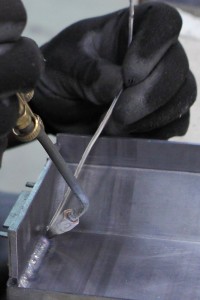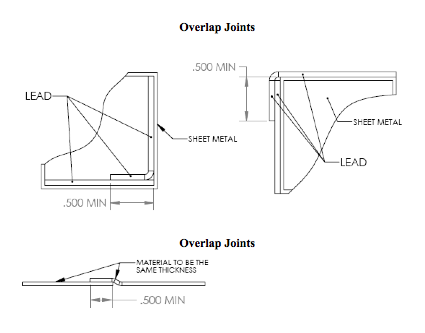Radiation shielding is a key benefit of lead and lead lining. There are five primary methods of shielding in joints between mating parts in a design. Each joint design has its own benefits and cost based on the requirements and geometry of the part. Hopefully this outline will help you to discuss and/or select from the different options of joint design.
is a key benefit of lead and lead lining. There are five primary methods of shielding in joints between mating parts in a design. Each joint design has its own benefits and cost based on the requirements and geometry of the part. Hopefully this outline will help you to discuss and/or select from the different options of joint design.
Five different types of joint design for radiation shielding projects
Butt Joint: This joint is the most basic one. With this joint, two lead sheets are abutting each other. While it is the least expensive option, there is a straight path through the part or wall section allowing radiation to potentially leak.
 Overlap Joint: This type of joint is where a sheet of lead is laid over another for a set length to give you two times the thickness of shielding in that area. This works well to prevent seams and shield radiation, but you will need the space for the lead thickness to be double the thickness in this area. Also this can only be done with thinner lead sheets. Lead plates that are thicker or those with antimony cannot be formed to the tight sheet you are trying to overlap.
Overlap Joint: This type of joint is where a sheet of lead is laid over another for a set length to give you two times the thickness of shielding in that area. This works well to prevent seams and shield radiation, but you will need the space for the lead thickness to be double the thickness in this area. Also this can only be done with thinner lead sheets. Lead plates that are thicker or those with antimony cannot be formed to the tight sheet you are trying to overlap.
Step Joint: A step joint is one where the part has been machined on the edges to allow the matting part to seat into the next part which offers uniform thickness. For example, in a half inch lead plate, a step joint may be one inch wide and cut down a quarter inch to allow the next plate to sit upside down into this one. The joint then looks like stair steps, which provide uniform wall thickness to prevent radiation leaks.
Offset Joint: This technique is used when the sheets or plates of lead are thinner than the total thickness and the butt joints are staggered in the design. This means there are no joints in the same place and the next layer of lead sheet covers the joint on the prior layer.
Weld Joint: When the seam in a lead part is welded or burned together, it is referred to as a weld joint. Filler lead is used to fuse the joint together. This method can offer a weld that provides great radiation shielding with no joint left when complete. The weld shields because it is the same alloy as the part. This technique does not add wall thickness because the lead weld joint is the same thickness as the base material. This technique can also aid in bonding the lead to other metals like aluminum or sheet metal.
Joint covers & corner strips
If there are butt joints, some designs will require lead strips to be used in the design to cover them. These can be welded, glued or attached in the design to shield. Also through forming or extrusion, corner strips can be made to cover corners and edges to prevent radiation leaks. This works well in X-ray cabinets.
Radiation shielding is a great process to finish your project or parts. But it’s important to carefully consider which joint design you should choose to ensure that no issues – such as leaking – occurs in the final product.
Contact us today and we will help you determine the best joint design for your radiation shielding project.

